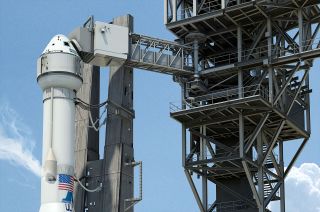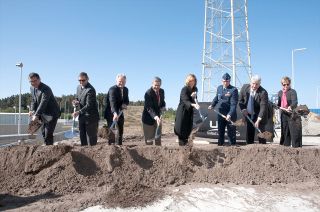Boeing, ULA Break Ground on New Astronaut Access Tower for Atlas Launches

Fifty-three years to the day after John Glenn ascended an access tower to become the first U.S. astronaut to ride an Atlas rocket into orbit, officials with United Launch Alliance and Boeing broke ground for the next gantry that will support Atlas crewed launches.
The groundbreaking ceremony on Friday (Feb. 20) marked the beginning of construction on the first new crew access structure at Cape Canaveral Air Force Station in decades. The tower will enable the Atlas V pad at Space Launch Complex 41 (SLC-41) to host astronauts and their support personnel for flight tests and missions to the International Space Station.
"Fifty-three years ago today, John Glenn became the first American to orbit the Earth, launching on an Atlas just a few miles from here," Jim Sponnick, the vice president of ULA's Atlas and Delta rocket programs, said at Friday's event. "The ULA team is very proud to be collaborating with Boeing and NASA on the Commercial Crew Program to continue that legacy and to return America to launching astronauts to the station." [Boeing's Private Space Taxi in Photos]
When completed, the 200-foot-tall (61-meter) tower will be used for launches of Boeing's CST-100 crew capsule atop ULA Atlas V rockets. In September 2014, NASA awarded Boeing a $4.2 billion contract to finalize the design of its commercial crew transportation system and to certify it for astronaut launches to the space station by 2017.
Boeing and ULA designed the metal latticework structure to be modular such that large sections of the tower will be constructed away from the pad and then trucked in and stacked, allowing assembly to be completed between on-going Atlas V unmanned launches. It is expected to take about 18 months to erect the structure.
"This is truly an integrated effort by a lot of partners," said John Mulholland, Boeing's vice president of commercial programs. "This is the first construction of its type on the Cape since the '60s, so building this crew tower [to return] the human launch capability to the United States, is very significant."
The crew access structure will visually stand out at SLC-41, largely because the launch complex is a "clean pad" design with only a reinforced concrete hard stand and four lightning towers in place. About 1,800 feet (550 meters) to the south is the Vertical Integration Facility (VIF), which houses the cranes and work platforms used to assemble the Atlas V rockets.
Get the Space.com Newsletter
Breaking space news, the latest updates on rocket launches, skywatching events and more!
"Besides the VIF and lightning towers, the crew access tower will be the tallest structure at the launch site," said Howard Biegler, human launch services lead for ULA.
The Atlas V launch pad has only been used for unmanned spacecraft to this point, hosting Titan rockets beginning in 1965 and then the Atlas V since 2002. NASA missions launched from SLC-41 include the Viking Mars landers, the Voyager spacecraft that toured the outer planets, the New Horizons probe that will fly by Pluto this July and the Curiosity rover currently traversing Mars.

Although the pad has supported previous spacecraft and probes, the demands for handling a capsule that will carry humans are greater. For example, the rocket cannot be rolled to the pad and fueled while astronauts are onboard. Safety considerations also require a way to get away from the rocket quickly in case of an emergency before liftoff.
"This is a shining example of the progress we'll see along the space coast as industry works toward safely flying our astronauts to and from the space station," Kathy Lueders, NASA's Commercial Crew Program manager, said. "Once this crew access tower is complete, this historical launch complex will be an integral part of a new era in human spaceflight."
Click through to collectSPACE to watch a video about the Atlas V astronaut access tower.
Follow collectSPACE.com on Facebook and on Twitter at @collectSPACE. Copyright 2015 collectSPACE.com. All rights reserved.
Join our Space Forums to keep talking space on the latest missions, night sky and more! And if you have a news tip, correction or comment, let us know at: community@space.com.

Robert Pearlman is a space historian, journalist and the founder and editor of collectSPACE.com, an online publication and community devoted to space history with a particular focus on how and where space exploration intersects with pop culture. Pearlman is also a contributing writer for Space.com and co-author of "Space Stations: The Art, Science, and Reality of Working in Space” published by Smithsonian Books in 2018. He previously developed online content for the National Space Society and Apollo 11 moonwalker Buzz Aldrin, helped establish the space tourism company Space Adventures and currently serves on the History Committee of the American Astronautical Society, the advisory committee for The Mars Generation and leadership board of For All Moonkind. In 2009, he was inducted into the U.S. Space Camp Hall of Fame in Huntsville, Alabama. In 2021, he was honored by the American Astronautical Society with the Ordway Award for Sustained Excellence in Spaceflight History.

